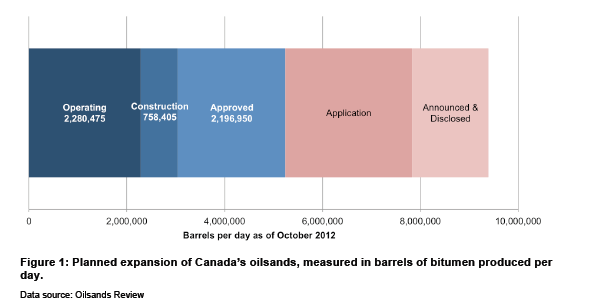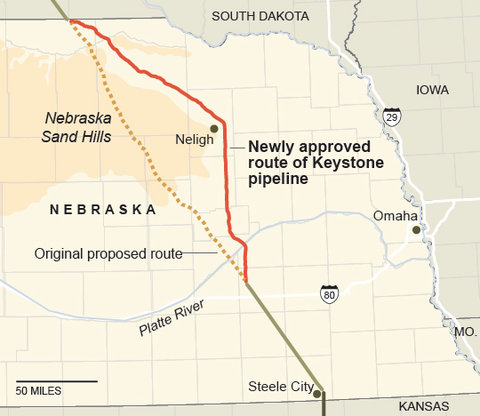
The US State Department has released a draft Supplemental Environmental Impact Statement (SEIS) on the proposed Keystone XL pipeline project which was immediately subjected to harsh criticism from scientists and environmental groups. The primary objection to the SEIS has been to this statement in Section ES.6.2:
"Approval or denial of any one crude oil transport project, including the proposed Project, remains unlikely to significantly impact the rate of extraction in the oil sands, or the continued demand for heavy crude oil at refineries in the U.S."
The conclusion that the tar sands will be developed with or without Keystone XL is based on the assumption that rail transportation can be ramped up to handle as much as 6 to 9 million barrels of tar sands oil per day by 2030 – a claim which on its face seems implausible, and which the draft SEIS report did not support very well. Many Canadian government and oil industry officials also seem to think Keystone XL is critical to maximize tar sands extraction, especially given how intensely they're lobbying for it. Anthony Swift at NRDC has also made a compelling argument that this conclusion is fundamentally flawed.
The SEIS also concludes that denying the Keystone XL permit will reduce overall emissions by up to 5.3 million tonnes of CO2-equivalent emissions per year if other proposed tar sands pipeline projects are also denied (a very plausible scenario given public opposition in Canada). This CO2 reduction would be equivalent to removing about 1 million cars from the road. That number will be even larger if the State Department is wrong and rail transport is unable to handle 6 to 9 million barrels of tar sands oil every day.
To date, only about one-third of the 9 million barrels per day tar sands potential is currently under construction (Figure 1). In addition to directly reducing greenhouse gas emissions, rejecting Keystone XL would also send a powerful and negative message to prospective investors in planned, future capital-intensive projects to extract oil from the tar sands.
The State Department has jurisdiction over the Keystone XL project because the pipeline would cross the border between Canada and the USA. According to the National Environmental Policy Act (NEPA), US government agencies must develop an EIS for any project which could significantly affect the quality of the human environment. An EIS describes the positive and negative environmental effects of the proposed action. A public comment period is then allowed so that interested parties can provide their opinions about the draft EIS and the proposed project. The State Department will respond to the public comments and issue a final SEIS.
There have been several EIS report iterations for the Keystone XL project, as the proposed pipeline construction path has been changed to avoid the potential for spills to contaminate the critical Ogallala aquifer.

The US Environmental Protection Agency (EPA) also has the authority to comment on the Keystone XL EIS, and noted that the draft SEIS produced in 2011 did not contain sufficient information to address potential environmental objections, for example regarding the project's greenhouse gas emissions and potential for spills to impact groundwater resources. The EPA will also undoubtedly comment on this latest State Department Keystone XL draft SEIS.
It's also important to bear in mind that as the SEIS cover letter notes, it is just one factor which will be considered in the ultimate decision as to whether the State Department will approve or reject the Keystone XL permit.
"Ultimately, a determination will be made on whether this project serves the national interest. The national interest determination will involve consideration of many factors, including: energy security; environmental, cultural, and economic impacts; foreign policy; and compliance with relevant federal regulations. As directed by Executive Order 13337, before making such a decision, the Department will also request the views of several agencies and officials, including: the Departments of Defense, Justice, Interior, Commerce, Transportation, Energy, Homeland Security, and the Environmental Protection Agency."
The ultimate decision will be made by Secretary of State John Kerry and President Obama. Even if they accept the draft SEIS conclusion that Keystone XL does not pose an unacceptable threat to public or environmental health, the project may still be deemed to not be in the national interest. For example, it would raise gasoline prices in the USA and would provide very few temporary construction or long-term jobs, while posing the threat of contamination due to pipeline spills, as well as increasing greenhouse gas emissions.
Section 1.4 of the SEIS argues the case that the tar sands will inevitably be developed with or without Keystone XL.
"If the proposed Project were denied but other proposed new and expanded pipelines go forward, the incremental decrease in production could be approximately 20,000 to 30,000 bpd (from 0.4 to 0.6 percent of total WCSB production) by 2030"
and
"If all such pipeline capacity were restricted in the medium-to-long-term, the incremental increase in cost of the non-pipeline transport options could result in a decrease in production from the oil sands, perhaps 90,000 to 210,000 barrels per day (bpd) (approximately 2 to 4 percent) by 2030"
The main alternative to pipeline transport of tar sands oil is via rail (train). This is a somewhat more expensive option, approximately $5 per barrel according to the SEIS, but substantially more according to NRDC. The SEIS argues that it will nevertheless be financially viable, based on projected crude oil prices, but that may not be true if the SEIS has underestimated the cost of rail transport.
Additionally, there are already 48,000 rail cars on backorder in North America, and there is an 18- to 24-month waiting period for new tank cars in Canada. It's not entirely clear that rail transport will be able to pick up the slack if the proposed pipeline projects are rejected – in fact, many Canadian government and oil industry officials seem to think Keystone XL is key to maximizing tar sands extraction. The SEIS justifies its conclusion that rail could nearly match pipeline transportation capabilities by drawing a comparison to a rapid increase in coal rail transportation from the Powder River Basin and oil from the Bakken oil field in North Dakota.
On its face it does not seem plausible that trains could transport 6 to 9 million barrels of tar sands oil per day in 2030. Using 600-barrel tank cars and 100-car trains with a 9 day transit time to the Gulf Coast, this would require 2,000–3,000 locomotives and 200,000–300,000 tanker cars making constant trips, with 200–300 trains coming and going from the tar sands each day. The logistics would be mind-boggling.
It's also worth noting that, as InsideClimate News reports, this section of the SEIS was based on analysis provided by two consulting firms with ties to oil and pipeline companies that could benefit from the proposed project.
The problem is that the State Department draft EIS has not considered the scenario in which alternative transportation options are unable to pick up the slack, thus slowing the extraction and transportation of tar sands oil. In that scenario, rejection of the Keystone XL permit could reduce the tar sands' overall climate impact even further.
The EPA comments on the 2011 draft SEIS estimated that Keystone XL could lead to as much as an extra 23 million tonnes of CO2-equivalent emissions per year, which is a factor of 4 higher than in the estimated maximum in the 2013 draft EIS. Thus it is entirely possible that the EPA will once again comment on this point.
Whether it's 5.3 million tonnes of CO2-equivalent emissions per year (State Department estimate maximum) or 23 million tonnes per year (EPA estimate maximum) it's a significant amount of greenhouse gas emissions. These emissions must be considered in the decision to approve or reject the pipeline permit. It would be the equivalent of adding approximately 1 to 4 million passenger vehicles to the road.
The EPA also requested that the State Department consider the social cost of carbon (SCC – an estimate of the economic damage caused by carbon emissions via climate change) from these emissions, which it appears to have bypassed in the new draft SEIS by arguing that the increased emissions would be negligible compared to overall tar sands production. However, the SCC (generally between $20 and $100 per tonne of CO2 emissions) for 5.3 to 23 million tonnes of CO2 per year ranges from approximately $100 million to $2.3 billion per year – clearly a very high cost to overlook.
The draft SEIS has certain key shortcomings.
The draft SEIS is now undergoing a 45-day public review period. Comments can be submitted via email to keystonecomments@state.gov.
The central argument of the SEIS is that a rejection of the Keystone XL pipeline will slow but not stop the tar sands expansion. Significant volumes of tar sands oil can be shipped by rail, and by making adjustments and upgrades to existing pipelines. However, NRDC has made a compelling case that the SEIS may have significantly overestimated rail transportation capabilities and economic viability.
If the Keystone XL permit were to be rejected, it would send a powerful and negative message to prospective investors in planned, future capital-intensive projects. There are many uncertainties considered in evaluating the economics of long-term projects like these, and the message that the US is not interested in aiding the development of the tar sands would be a very powerful one. In this sense, the Keystone XL pipeline is indeed key to tar sands development.
That said, reducing global demand for all fossil fuels is the only long-term solution to mitigating climate change. Putting a price on carbon emissions in the USA, Canada, and other countries would go a long way to addressing this problem, particularly for the costly and high-carbon oil from the tar sands, as this 2010 study from MIT demonstrates.
Secretary Kerry and President Obama must not only decide whether permitting Keystone XL is worth potentially adding the equivalent emissions of millions of cars on the road, the inevitable pipeline leaks/spills and associated impacts on environmental and public health, and the resulting higher gasoline prices in the USA. They must also consider that approval of Keystone XL will set the energy course of the US more firmly in the direction of fossil fuels, thus antagonizing the groups working to preserve a safe climate for future generations. As the New York Times Editorial Board put it,
"A president who has repeatedly identified climate change as one of humanity’s most pressing dangers cannot in good conscience approve a project that — even by the State Department’s most cautious calculations — can only add to the problem."
While Keystone XL is an important battle, we also have to remember that it's just one front in the overall war to reduce global greenhouse gas emissions. Our ultimate goal must be to reduce global fossil fuel demand so that the tar sands and other fossil fuel projects like it fail simply because in the full context of their environmental and climate implications, they are understood to be uneconomical. The war will be won when there is no demand for tar sands oil.
Posted by dana1981 on Wednesday, 13 March, 2013
 |
The Skeptical Science website by Skeptical Science is licensed under a Creative Commons Attribution 3.0 Unported License. |